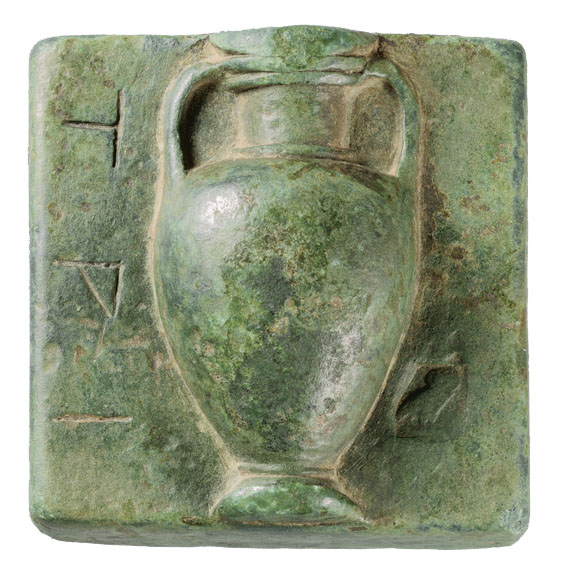
-
Copyright credit: J. Paul Getty Museum

ARCHAEOLOGICAL DESCRIPTION OF THE WEIGHT
Authority
Mint
Athens
Denomination
1/3 Stater
Material
Copper alloy (bronze or brass)
Manufacture
Cast
Shape
Square
Length
5.24 cm
(2.0625 inch)
Width
5.24 cm
(2.0625 inch)
Height
- cm
Metrology
| Mass (g) | Mass (grain) | Date of measurement | Reference | fragmented | cleaned | reference weight |
|---|---|---|---|---|---|---|
| 277.01 | 4274.9006 | - | www.getty.edu | No | No | Yes |
Iconography
| Symbol | Technique | Direction | Position | Number | Synecdoche |
|---|---|---|---|---|---|
| Amphora | Relief | UP | |||
| Owl | Stamped / Countermarked / Struck | UP |
Wear
Corrosion
Handle
No
Suspension hole
No
Recarved mould
No
Recarved weight
No
Intentionally destroyed
No
Archaeological description
In antiquity, the Athenian government kept sets of official weights used to calibrate and verify the accuracy of other weights used in the city. These official weights were made of bronze rather than the usual, more easily alterable lead used for other weights. They also carried an inscription indicating that they belonged to the Demosion or public. This thick, square plaque is an Athenian official weight dating to the period from about 450 to 400 B.C. The symbol of an amphora in high relief and the inscription on the front indicate its value. The letters are an abbreviation for tritemorion, or one-third of a stater, a basic unit of weight at this time. The dotted inscription on the side of the weight is the abbreviation for Demosion. The stamped image of an owl, the symbol of Athens, on the front and side of the plaque are countermarks, indicating that the weight was periodically inspected. The back of the plaque is plain except for a rectangular cutting filled with lead to adjust the weight.
Autopsy
No
INSCRIPTION
| Language | Technique | Legend type |
|---|---|---|
| Greek | Incised | Denomination, Legal status |
Fac simile
Edition
Τρι(τημόριον)
Δε(μόσιον)
Δε(μόσιον)
Monogram
ARCHAEOLOGICAL CONTEXT
Findspot (region)
Findspot (site)
context
CIRCUMSTANCES OF ACQUISITION
Region
City
Date of first acquisition
circumstances
Gift of Barbara and Lawrence Fleischman (New York, 1925 - New York, 1997) to the J. Paul Getty Museum in 1996. Sold to Barbara and Lawrence Fleischman in 1988, Fritz Bürki & Son (Zurich, Switzerland).
DATING OF THE WEIGHT
Curatorial Section
GREEK
Time frame
FROM
-450
TO
-400
Comments on Chronology
Second half of 5th century B.C.
COLLECTION HISTORY
Collection
| Name | Date of acquisition | Inventory number |
|---|---|---|
| Fleischman Collection | Jan. 1, 1988 | F121 |
| Getty Museum – Getty Villa (Malibu) | Jan. 1, 1996 | 96.AC.83 |
Bibliography
| Reference | Page/Column | Reference (number) | Plate / Figure | Comment |
|---|---|---|---|---|
| Neils 1992 | 51, 191 | 70 | (non vidi) | |
| True and Hamma 1994 | 70 | 25 | ||
| Bodel and Tracy 1997 | 7 | (non vidi) | ||
| Getty Museum 1997–98 | 64 |
VARIA
Additional comment
Permalink